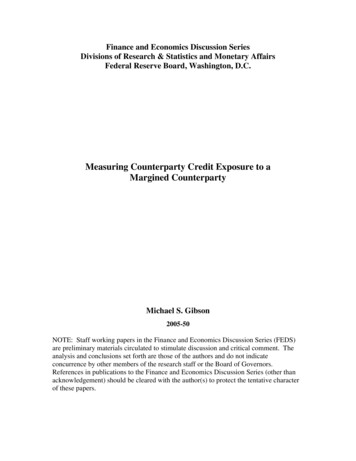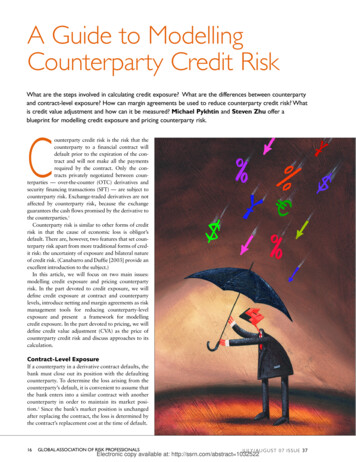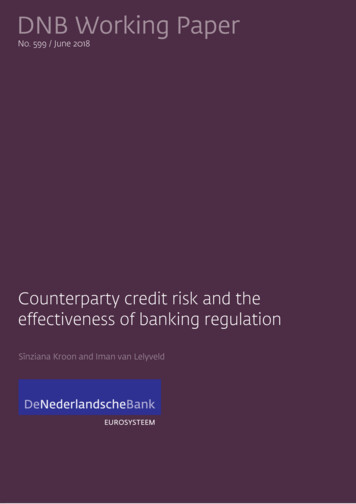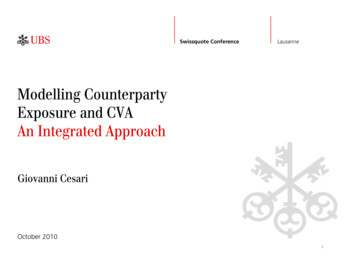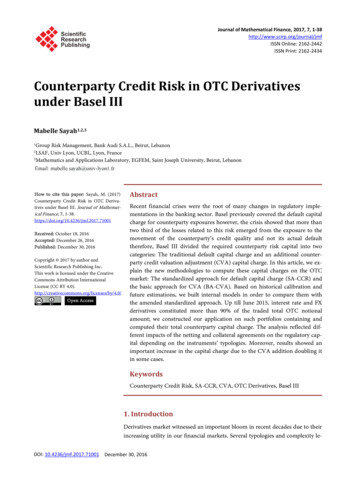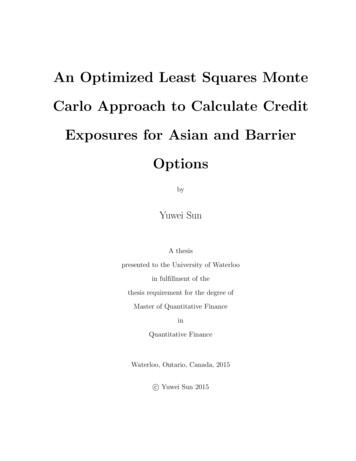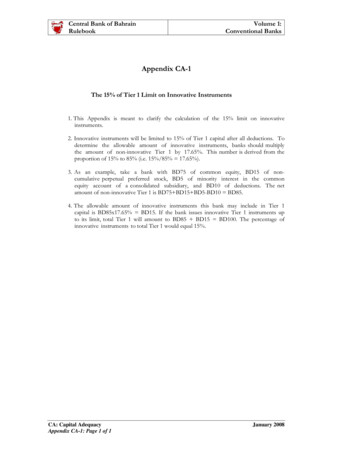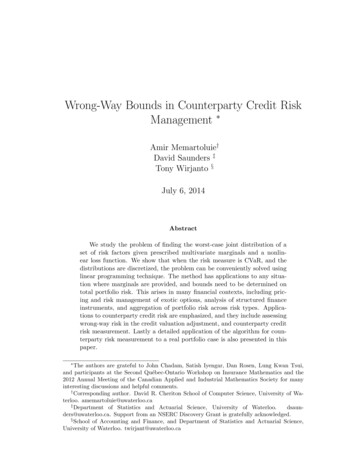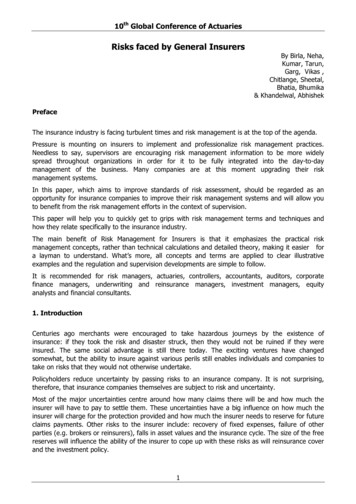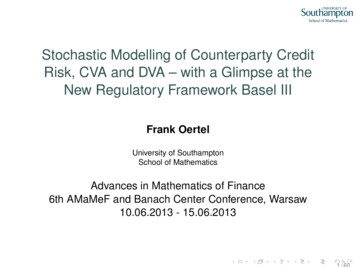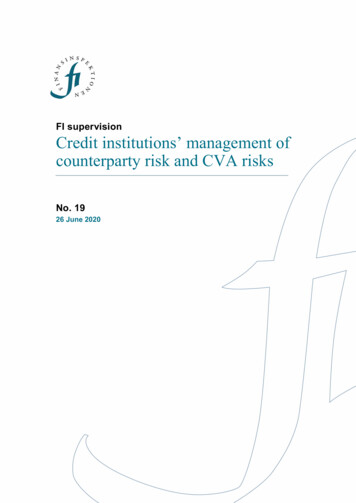
Transcription
FI supervisionCredit institutions’ management ofcounterparty risk and CVA risksNo. 1926 June 2020
FINANSINSPEKTIONENCREDIT INSTITUTIONS’ MANAGEMENT OF COUNTERPARTY RISK AND CVA RISKSSummaryFinansinspektionen (FI) has conducted an investigation into a number ofcredit institutions’ exposures, risk measurement and management ofcounterparty risk and credit valuation adjustment (CVA) risk related topositions in financial derivatives. Through the investigation, FI identified thatthese institutions need to focus on developing the risk sensitivity andprecision of their existing methods and measures for quantifying of exposureamounts and valuations, and also strengthen aspects of how they managecounterparty risks in derivatives. All of the investigated institutions have nowinitiated improvement programmes with the aim of developing riskmeasurement and risk management.In 2019, Finansinspektionen (FI) completed a comprehensiveinvestigation into a number of credit institutions’ exposure, riskmeasurement and management of counterparty risks and creditvaluation adjustment risks (referred to below as CVA risks) that arerelated to their positions in derivatives. As part of this investigation,FI studied a selection of the credit institutions with positions inderivatives as an important component of their respective businessmodels and, as a result, are particularly exposed to the dynamic risksthat derivative positions can entail.In addition to market risks, positions in derivatives can also entailcounterparty and CVA risks. In a derivative, counterparty risk is therisk that the counterparty in a transaction will default prior to theexpiration date and final settlement. In simple terms, counterparty riskin a derivative depends on the development of the derivativecontract’s underlying market risk factors, and the probability that thecounterparty will default during the lifetime of the derivative contract.Losses arise if one or more of the transactions with the counterpartyhave a positive economic value at the time the counterparty defaults.In simple terms, the CVA is the current market price of thecounterparty risk and CVA constitutes an adjustment of the risk-freefair value taking into account the price of the counterparty risk. TheCVA risk indicates the uncertainty of the CVA and, hence, the profitand-loss volatility caused by the CVA.Counterparty and CVA risks may lead to substantial losses for a creditinstitution and can also lead to disruption to the institution’s operatingactivities, for example in respect of its ability to hedge undesirablerisks.Counterparty risk is a dynamic risk and can alter rapidly when marketconditions change or when the financial stability of the counterparty iscalled into question. This became especially clear in the COVID-19outbreak and the market turbulence that followed in March and April2020. The sharp increase in volatility in credit spreads and othermarket risk factors, combined with a general increase in credit spreadlevels, resulted in large increases in counterparty risk and CVA for anumber of banks and credit institutions globally.2 SUMMARY
FINANSINSPEKTIONENCREDIT INSTITUTIONS’ MANAGEMENT OF COUNTERPARTY RISK AND CVA RISKSIn many respects, counterparty risk and CVA are complicated toidentity and model. This imply challenges for credit institutions’capacity and ability to frequently value, measure and manage thoserisks.FI’s investigation focused on five main areas:1. quantitative risk measurement, valuation and valueadjustment,2. risk mitigation with regards to the risk associated with noncleared derivatives,3. credit institutions’ internal instructions for taking on newproducts and markets,4. stress tests, and5. internal risk management and governance.With regard to risk measurement, valuation and value adjustment, theinvestigation focussed on institutions’ quantification of exposureamounts, calculation of CVA and management of valuationuncertainties and correlation risk.The investigation shows that credit institutions’ methods formeasuring counterparty risk and CVA differ in terms of howcomprehensive and risk sensitive the methods are. Consequently, thereare also differences in institutions’ access to sophisticated and reliablerisk measures. FI’s assessment is that the methodological differencesbetween institutions are generally larger than the differences in thepositions taken and, hence, the exposure to risk. In light of this, FImakes the assessment that there is a need in many cases for creditinstitutions to develop their methods further to increase their risksensitivity and thus their capacity to measure counterparty risk anddetermine CVA. This is particularly pertinent with respect tomodelling of underlying market dynamics and exposures subject tothe structure of the derivatives.Furthermore, FI notes in the investigation that credit institutions faceschallenges when it comes to continuous identification, internal andexternal reporting, and following up on correlation risk (aspects ofwrong-way-risk), i.e. how counterparty risk and CVA are affected byunderlying relationships between exposure and probability of default.These challenges include establishing procedures, methods and ITsystems. In many cases, institutions do not conduct identification,modelling or reporting of such relationships.In terms of risk mitigating measures to limit the risk of non-clearedderivatives, the investigation shows that all institutions have internalprocedures for reducing the risk of OTC derivatives that are notcleared by a central counterparty. However, FI would like to seefurther improvements at the institutions when it comes to increasingthe level of detail and clarity of their internal instructions andprocedures. This is particularly relevant given that non-financialcounterparties enter into CSA agreements with credit institutions onlyto a limited extent.SUMMARY 3
FINANSINSPEKTIONENCREDIT INSTITUTIONS’ MANAGEMENT OF COUNTERPARTY RISK AND CVA RISKSThe investigation shows that credit institutions’ internal instructionsfor counterparty and CVA risk for new products and marketsgenerally need to be revised so that these instructions are moreconsistent with the institutions’ existing internal processes. FI alsoexpects institutions to conduct reviews of and focus on strengtheningexisting processes and documentation pertaining to the approval ofnew products, counterparties and markets so that these are consistentwith the institutions’ potential to value, measure and follow up risk forall transactions that are entered into.Based on the results of the investigation, FI generally concludes thatthere is room for further improvement in terms of the institutions’design and set-up of stress testing, in particular in the development ofassumptions, scenarios and risk factors that are included in their stresstests so that these better correspond to the institutions’ derivativebusiness. In addition, institutions can improve their descriptions of theunderlying assumptions, justifications and reasoning that are usedwhen designing stress tests. There are also challenges for institutionswhen it comes to estimating the effects and consequences of replacingcontracts and the closing costs in the event of counterparty default orsignificant market stress.FI also investigated institutions’ internal risk management andgovernance within a number of areas such as risk appetite, limitsetting, escalation and reporting. The investigation reveals that, inmany cases, institutions do not have an explicitly designed riskappetite for exposure to counterparty risk. However, the investigationalso shows that several credit institutions have limits and mandates fortheir exposures, as well as set maximum levels for contributions tocentral counterparties’ default funds. In addition, the investigationshows that a number of the institutions investigated have implementedtrading restrictions for certain groups of counterparties.FI notes that risk indicators and risk factors are applied differentlyamong credit institutions. Furthermore, FI assesses that, in severalcases, there is no consistent management of counterparty risk andCVA on the basis of a comprehensive risk perspective that capturesthe risk dynamics that accompany derivative positions. For example,FI sees room for improvement in terms of internal risk reporting basedon a broader risk perspective that, compared with the current situation,includes additional risk aspects, as well as escalation routines andmanagement of limit violations as a result of changes in underlyingmarket risk factors.As part of FI’s recurrent dialogue with the credit institutionsinvestigated, all institutions have decided to take action on the basis ofFI’s observations and assessments. They have also establishedimprovement programmes in several parts of their risk measurementand risk management. FI generally agrees with the institutions’planned improvement programmes and internal action plans.4 SUMMARY
Losses arise if one or more of the transactions with the counterparty have a positive economic value at the time the counterparty defaults. In simple terms, the CVA is the current market price of the counterparty risk and CVA constitutes an adjustment of the risk-free fair value taking into account the price of the counterparty risk. The
